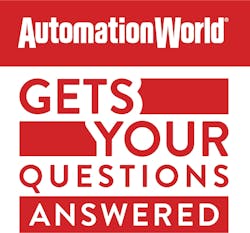Can Internet of Things Technology Improve Safety?
TRANSCRIPT
David Greenfield, Automation World
Welcome to the Automation World Gets Your Questions Answered podcast where we connect with industry experts to get the answers you need about industrial automation technologies. I'm David Greenfield, editor in chief at Automation World and the question we'll be answering in this episode is: Can Internet of Things technology improve safety?
Joining me to answer this question is Devin Murray with Schmersal USA, a supplier of safety switchgear devices and systems for personnel and machine protection. Devin works in Schmersal’s technical engineering services division called tec.nicum, which focuses on machine safety such as risk assessments, validations and training.
So, thanks for joining us again, Devin. I think this marks your third appearance on our podcast now.
Devin Murray, Schmersal USA
Yeah, for sure. Thanks for having me. Always good questions, too. So hopefully, we can get some good discussions going as usual.
David Greenfield, Automation World
Yes, you always provide good answers. We really appreciate you taking part in these. So, Devin, we've all heard lots about the Internet of Things and how the connectivity concepts that underlie it support the collection and analysis of massive amounts of equipment and process data for better decision making around production process improvements. But can IoT also be leveraged to improve safety? And, if so, how is that, in its simplest terms, done.
Devin Murray, Schmersal USA
Safety can be applied to the Internet of Things to not only improve safety, in general, but also the efficiency with safety. If you think about just collecting the information from the sensors level, for example, how often a guard door was opening or how often an e-stop is being actuated. Sometimes those are actuated unintentionally. And once you can start collecting that type of information and having historical data to see that these e-stops are being triggered unintentionally, the data can help determine that, maybe, we need to reposition this e-stop. But also it’s about being able to receive this information live, not just historical data.
Let's say there is an instance where someone has an e-stop with data being collected it from it immediately. And you can then say, you know what, we want to send that type of information to all the EHS managers and the plant manager so that you have that live feedback, that live response. There's so many different data that can be collected from safety components that can also be applied to what we see with the automation side from the machines.
David Greenfield, Automation World
So I guess this concept around IoT, that it is an Internet of “Things”, so to speak, that really does translate to any “thing” that's out of that floor, no matter what it is—not just equipment data for efficiency analysis and such. So, can you explain more about how this impacts the various safety devices used in manufacturing? You touched on e-stops, for example, but even beyond that into devices such as safety controllers and sensors.
Devin Murray, Schmersal USA
Yeah, so honestly, looking at devices in the industry from manufacturers that are involved with the Internet of Things and Industry 4.0 and the idea of the smart factory, you're seeing more devices being offered that have the built-in smarts. Essentially they're able to communicate over a local network using some form of protocol. And what we are now seeing is those protocols taken at the local level and now, for the Internet of Things, they’re being taken to the cloud.
So we're now seeing a lot more of what we call smart devices within the industry, even those without the electrical mechanical components that are safety rated, that can be used for different types of safety application to convert a signal and put it on the network. But the idea behind the smart factory is all about having those smart devices, so we’re definitely see a lot more of those within the industry that have a built-in capability to communicate.
David Greenfield, Automation World
For a supplier of a safety devices such as Schmersal, how does that impact what you develop for use in the manufacturing industries given the broader use of these devices now compared to how they were used historically?
Devin Murray, Schmersal USA
I can say honestly, that Schmersal has always been one of the more forward-thinking companies and we've long offered smart devices. You can see an example of that with our new devices with the Pulse Echo technology. So, I don't know if it changes the way that we go to market or what we offer, but it definitely expands our offerings. And we keep that same forward-looking mentality that we have with designing and developing products and implementing those safe, smart components. So having our large offering of the safety devices and incorporating that smart element of it—being able to have devices from the sensor level to the logic level and giving them the ability to communicate more and have more diagnostics so that we can transmit that information to the cloud and have it available for the user so they can analyze that data and manipulate it as they need for their particular application in their smart factory.
David Greenfield, Automation World
So, looking beyond Schmersal products, what sort of key devices and features on those devices should manufacturers be looking for that can help them take advantage of IoT capabilities when they're looking to improve safety?
Devin Murray, Schmersal USA
So first and foremost, you really want to make sure that device can be used for that application. We definitely want to make sure that safety still comes first and foremost. And once we're able to find that device from a manufacturer that says this is going to be safe and appropriate for this application, you want to see if the manufacturer of that device offers that capability to communicate. And what that type of communication needs to be will depend on what type of protocol you want for that machine. Ultimately you want to be able to communicate the internal diagnostics of that device so that you can transmit that data to the cloud and be able to analyze specific information in it.
So, the type of information that you're looking for depends on the application and depends on what type of information that the manufacturer can deliver. But, again, at the base level, you want to make sure that that device can communicate over some form of a network.
David Greenfield, Automation World
We've talked a lot about the specific devices and how those devices collect and transmit data. And you've touched a little bit on the aggregation and analysis of this data for safety applications as well. But we’re always hearing about all these edge and cloud technologies that can handle this aggregation and analysis of data so how, from a safety aspect, are you seeing manufacturers approach this when they're looking to improve both production operations and safety at the same time?
Devin Murray, Schmersal USA
It's more about what the device can deliver for diagnostics. And I go back to our history as a manufacturer of safety components and what we've been able to deliver to the industry. We’ve always been able to deliver a lot of information from our diagnostics. And one of the key things, I think, for manufacturers of these safety components is being able to offer data that's going to be valuable—something that's more than just a cycle count of a door opening, but actual status of the actual switch. In other words, live information that the user can analyze and have this historical information available to determine when a device may fail dangerously, for example. Or allow them look at the temperature on a solenoid to predict that there may be a failure happening or look at a light curtain to see if there are any contaminants on it.
So, it’s about having more information from the device that the user can actually use for general safety and then just making their safety process more and more efficient.
David Greenfield, Automation World
Digging into this just a little deeper, around your work with manufacturers in a variety of industries, where would you say things stand now in terms of IoT technology deployment for safety? And I'm asking this because it's not something that's discussed as much as IoT for production improvements or strategic decision making. So, I'm wondering about industry’s uptake of IoT for safety specifically.
Devin Murray, Schmersal USA
Yeah. When we spoke last time about collaborative robots and how, with a new technology, there’s a wave of improvements around it within the industry, but safety kind of tends to lag behind. It’s similar here in that there’s all this new technology like AI, for example, but the safety aspects of it are lagging behind. But with the Internet of Things and the smart factory and Industry 4.0 concepts, I can honestly say that the framework for safety is there already. At the local level, we can definitely have a safe communication on the machine, whether it’s with CIP Safety or ProfiSafe. Now the question is taking that information from the local level and sending it to the cloud.
Then we have to worry about cybersecurity with functional safety, which wasn't the case before. But there are definitely standards that are in place or are in the works, at least, where we can apply certain aspects of safety tied with cybersecurity to make sure that, yes, we have a machine with safety functions that can communicate to the cloud, but make sure that it's still safe. And that means it’s safe from a malicious attack and safe from someone trying to troubleshoot the machine remotely and manipulating the safety of it—maybe not have any ill intent, but maybe they're not following the proper procedures and they’re causing an unsafe situation.
So yeah, the framework is there but there's definitely some T’s that need to be crossed and I’s that need to be dotted in order to say, yes, everything is fully in place and we can take it take it to its full capabilities.
David Greenfield, Automation World
So the framework is there, but manufacturers are still in the process of coming along with this or are you seeing some actual uptake of this already?
Devin Murray, Schmersal USA
Well, there has been some uptake early on, for sure. But just like with any standard, when you look at safety, it’s going take some time within the industry to be able to understand the standards and actually apply them. But again, the framework for cloud-based IoT safety is there. The framework for the safety aspects of cybersecurity is there. Now, it's just up to the industry to actually apply it to these smart factories, which makes this an exciting time for sure.
David Greenfield, Automation World
Well, thank you again for joining me for this podcast, Devin. And thanks, of course, to all our listeners. And please keep watching this space for more installments of Automation World Gets Your Questions Answered. And remember, you can find us online at automationworld.com to stay on top of the latest industrial automation technology insights, trends and news.




